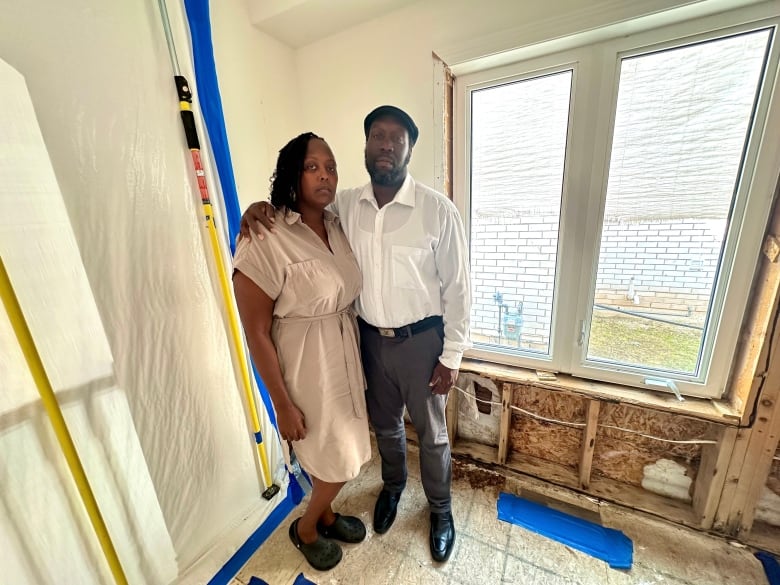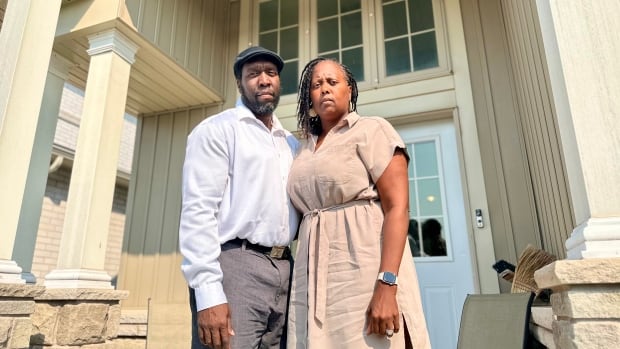Their house is four years old, but a Fort Erie, Ont., couple say it was so badly constructed that they have no choice but to spend hundreds of thousands of dollars to tear it down.
“I can’t stress how much our life is ruined, literally ruined, right now,” Carolynn Mayers, 53, told CBC Hamilton.
“Every day we have to look at how hard we worked to get nothing.”
Mayers and her husband, James Durban, 51, sat in the bungalow’s open concept living room next to a tidy kitchen, where they’d envisioned soon retiring — she works in sales and he’s a truck driver.
But those plans are on hold as they shoulder bills for lawyers and engineering specialists on top of their mortgage and day-to-day expenses.
“This is a situation I wouldn’t want anybody to go through,” Durban said.
They purchased the house in July 2021 from the original buyer, a year after it had been built as part of a 100-home subdivision by Marina Homes.
But after dealing with a host of problems, from leaking windows and roof to extensive water damage and persistent mould, they said they soon discovered an even bigger issue.
Mayers inspects areas of concern on the outside of her house. (Samantha Beattie/CBC)
The foundation is not strong enough to support the house, an engineering firm hired by the couple determined earlier this year.
“It is recommended that the building be completely demolished,” said the report seen by CBC Hamilton.
Mayers and Durban said they successfully claimed close to the maximum amount of coverage possible through Tarion — a non-profit organization that administers Ontario’s new home warranty program.
The fixed, maximum amount, based on when the house was purchased by the first owner, is $300,000, said Tarion spokesperson Andrew Donnachie.
“We agree that the amount may not be sufficient to entirely remove a foundation, demolish a home and rebuild the home, however, based on our data, that is an exceedingly rare situation,” Donnachie said.
Homeowners file $3M lawsuit
The couple said it isn’t enough money to tear down and rebuild their house, and they weren’t able to reach an agreement with Marina Homes.
They said they had no other option but to sue Marina Homes, house designer Sandy Gull Zone and the Town of Fort Erie for $3 million. The couple filed the civil lawsuit over a year ago.
Mayers and James allege the town failed to ensure the home was designed and constructed in a way that meets provincial building standards before issuing building and occupancy permits.
All defendants deny responsibility and the allegations have not been proven in court.
Lawyers for Zone and the town declined to comment as court proceedings are ongoing.
In her statement of defence, Zone said while she provided architectural designs, the builder didn’t construct Mayers’s and Durban’s home as she’d advised.
Jason Mangano, lawyer for Marina Homes, said in a statement the builder’s top priorities are safety and quality, and it is “actively working to try to find a satisfactory resolution.”
“They have strict protocols for building code compliance and work closely with engineers and inspectors to ensure that all homes constructed meet or exceed these standards,” he said.
In its statement of defence, Marina Homes said the house was constructed “in a workmanlike manner” under the Ontario Building Code. Any damage or deficiencies is either caused by “inadequate” design or because of decisions the homeowners made, such as not maintaining or properly inspecting the property, and refusing to allow Marina to make repairs.
In their statement of claim, Mayers and Durban argue the $3 million will cover all rebuilding costs, plus “future financial loss as a consequence of the resulting market stigma.”
As well, they argue they’ve also suffered physically, emotionally and mentally from “intolerable living conditions,” including “toxic” mould, and mildew and stress, the statement said.
Health Canada says people living in homes with mould are more likely to experience eye, nose and throat irritation, coughing and shortness of breath. It may also lead to developing asthma, bronchitis and eczema, according to its website.
It advises that as long as moisture problems persist, mould will reappear even after it’s treated.
Mayers and Durban say they shouldn’t be living there for their own health and safety, but can’t afford to rent another place as the bills pile up and their house remains unsellable.
“At times it’s, ‘Do we eat or pay the bills?'” Mayers said. “It’s embarrassing, but we are praying and hoping this will create some awareness.”
Durban added, “We are going to do our best to ensure this doesn’t happen to anyone else.”
No home inspection before closing
The push to build more homes faster in Ontario is revealing cracks in the building, inspecting and buying process, said Karen Somerville, president of Canadians for Properly Built Homes, who did not comment specifically about this case but spoke generally.
The non-profit supports homeowners struggling with “serious construction issues” that violate the Ontario Building Code — a set of standards intended to protect public health and safety.
“What we’re seeing in the past few years is an increase in the number of people approaching our organization for help,” Somerville said. “They are usually in serious trouble.”
When Mayers and Durban bought the house in 2021, it was a competitive market and they decided to forgo getting an inspection.
 Mayers and Durban stand in their dining room, where they say some of the floor and walls had to be removed to address moisture and mould issues. (Samantha Beattie/CBC)
Mayers and Durban stand in their dining room, where they say some of the floor and walls had to be removed to address moisture and mould issues. (Samantha Beattie/CBC)
They felt at ease knowing the Town of Fort Erie had recently inspected and approved it for occupancy, plus they had the Tarion warranty if any issues arose, Mayers said.
It wasn’t until the home was in their names that they learned the previous owner had made claims with Tarion for a range of repairs, including for mould, but not the foundation, the couple said.
However, if they had known of any claims before closing, “100 per cent we would not have bought this house,” Mayers said.
But Tarion generally doesn’t release claim history until after the transfer is complete, said Donnachie. Buyers can only get the information before the sale closes if the seller agrees.
The town said in its statement of defence that it found no building code breaches during its inspections and if they existed, “they were not reasonably discoverable.”
‘Significant evidence of poor construction’
Over the next two years, issues with water penetration and mould persisted, Mayers said.
While Tarion was working to determine the extent of damage, Mayers and Durban hired their own experts, including James Federico and Associates.
The engineering firm found “significant evidence of poor construction throughout,” making the house “structurally inadequate.”
The foundation isn’t designed for the high level of groundwater under the house, hasn’t been waterproofed and the concrete is weaker than what’s allowed under the Ontario Building Code, says the report.
 Durban steps through a tarp covering half of his dining room. (Samantha Beattie/CBC)
Durban steps through a tarp covering half of his dining room. (Samantha Beattie/CBC)
The foundation needs to be completely replaced, the firm recommended. The house could be lifted up and then put back down on new foundation — an expensive process — but as there are neighbours on each side, there’s not enough room for the equipment.
CBC Hamilton spoke to two other homeowners who purchased houses by Marina Homes in the same subdivision. They said they’ve experienced serious issues with how their homes were constructed, but are reluctant to speak out and worried it will jeopardize their property values.
A pre-purchasing inspection report from 2021 for one of these homes across the street from Mayers and Durban indicated the foundation is in “poor” condition with cracks. Another inspection this year for the same house found water and moisture damage in the basement, as well as rotting wood and mould growth, said the report viewed by CBC.
Marina Homes, through its lawyer, did not directly address allegations from other homeowners who claim they’ve experienced issues.
CBC has not verified whether other homes in the subdivision have issues.
Regulator says it’s looking into concerns
Marina Homes’ Fort Erie development is listed on the Ontario Builder Registry as Marina (Green Acres) Development Inc.
The directory notes it failed to repair or resolve issues with homes in the subdivision 10 times as of March 31, which resulted in homeowners getting coverage through Tarion. The directory doesn’t specify the properties impacted and doesn’t capture every case, said Donnachie.
Marina Homes owes close to $60,000 in outstanding claims to Tarion, according to the directory. It has paid back just over $45,000.
There are no notices and orders, discipline history or court charges listed.
Ontario’s Home Construction Regulatory Authority (HCRA) runs the directory and investigates concerns about builders’ professional conduct.
Spokesperson Tess Lin said if HCRA learns of “a pattern of structural defects across multiple homes,” it could prompt further investigation.
“The HCRA is aware of concerns about the builder in question,” Lin said. “We are reviewing the situation but cannot comment further as the matter is ongoing.”
Marina Homes did not provide a comment directly to CBC that addresses the Tarion claims posted on the directory or the HCRA reviewing concerns.
Marina Homes also owns a large, empty plot of land next to Mayers’s and Durban’s subdivision. The Town of Fort Erie declined to provide any details about what permissions Marina Homes has applied for to develop it, citing the ongoing court process.
Toronto-based real estate lawyer Blair Drummie, who has no connection to the couple’s case, said the size of the Marina Homes development (over 100 homes) indicates it’s a “major builder” and if it’s not following the Ontario Building Code, “that’s a pretty big deal.”
He said the HRCA should add to Marina Homes’ profile that a lawsuit has been filed against it.
“I think that would be a triggering event that the public would want to know about,” Drummie said.
Mayers and Durban say something in the system needs to change, whether it’s access to more Tarion coverage, transparency about past claims, scrutiny from municipal inspectors or disciplinary action from HRCA.
“It’s been 20 years worth of my earnings going to fight a big giant who has millions of dollars and knows the average homeowner can only fight so far,” Mayers said.









